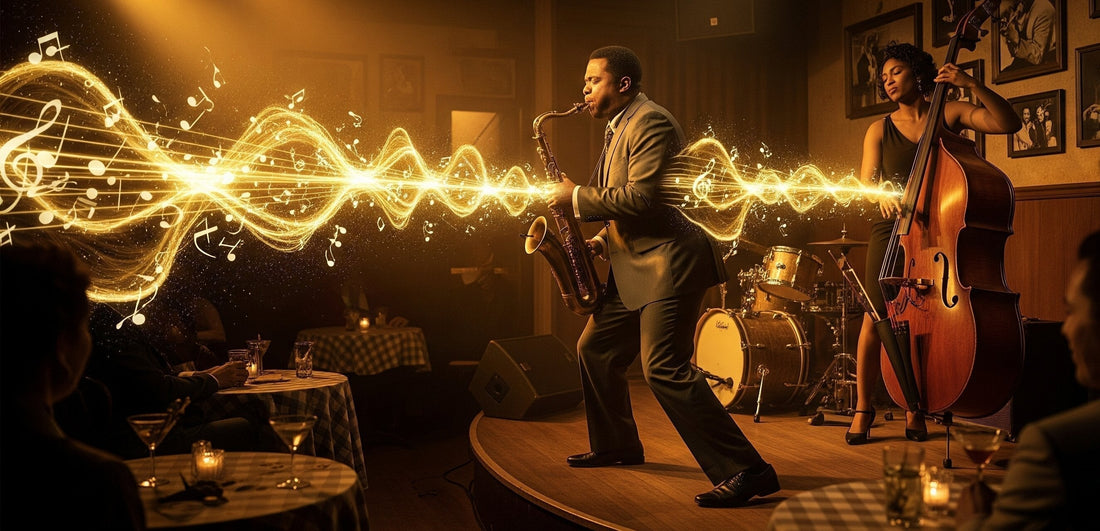
Jazz That Shines: 5 Classics to Bring Your Audio System to Life
Share
Jazz music is often a favorite among audiophiles due to its rich instrumentation, intricate details, and dynamic range. Capturing the subtle textures and tonal quality of jazz can truly bring audio equipment to life. Each pluck of the bass, the brush of a drum, and the depth of a saxophone solo reveals how well your audio setup reproduces sound with clarity and precision. Here, we highlight some jazz classics that shine on high-quality audio equipment.
Top 5 Jazz Classics to Test Audio Quality
These songs are perfect for testing audio equipment, each revealing a different dimension of tonal richness and depth.
1. "So What" by Miles Davis
- Why It’s Great for Testing: The minimalist opening of "So What" slowly builds, allowing listeners to hear each instrument as it enters. With clear audio, you’ll notice the warm tones of the bass and the subtle brush strokes on the drums, essential for true jazz appreciation.
2. "Take Five" by The Dave Brubeck Quartet
- Why It’s Great for Testing: Known for its unique 5/4 time signature, "Take Five" features complex rhythms and a stunning alto saxophone solo. Good equipment will highlight the song’s intricate percussion and the smooth, melodic lines of the saxophone.
3. "Naima" by John Coltrane
- Why It’s Great for Testing: A soulful ballad, "Naima" features Coltrane’s tenor saxophone with a warm, smooth tone. This track demands audio equipment that can capture the emotion in Coltrane’s playing while keeping the piano and basslines distinct.
4. "Blue in Green" by Bill Evans
- Why It’s Great for Testing: Bill Evans’ "Blue in Green" is a delicate piece featuring piano, trumpet, and saxophone. The gentle transitions between instruments test an audio setup’s ability to handle dynamic range without blending or losing detail.
5. "Moanin’" by Art Blakey and the Jazz Messengers
- Why It’s Great for Testing: This upbeat track is a perfect showcase for percussion clarity. Art Blakey’s drumming is energetic, with each hit offering insight into your audio equipment’s handling of transient response and rhythm.
Tips for Enhancing Your Jazz Listening Experience
Optimize What You Already Have
- Speaker / Headphone Positioning: Form an equilateral triangle with your listening spot; toe-in speakers slightly for a focused soundstage.
- Height & Ear Alignment: Aim tweeters at ear level; adjust headphone headband to center drivers over ears.
- Seating Position: Move your chair forward/back in small steps to smooth bass and improve clarity.
- Cable & Connection Check: Ensure firm plugs, correct polarity (+/−), and use short, reliable runs.
Improve the Listening Environment
- Reduce Reflections: Add rugs, curtains, sofas, and bookshelves to tame echo and brightness.
- First-Reflection Test: Sit at the listening spot; wherever you can see the speaker in a wall/ceiling mirror is a key reflection area to soften.
- Quiet the Room: Turn off fans/AC and reduce electrical hum; lower noise floor reveals micro-details.
- Speaker Isolation: Use stands or firm surfaces; avoid wobbly shelves to tighten bass and imaging.
Source Quality Matters
- Use Lossless/Hi-Res: Prefer FLAC/ALAC or high-bitrate streams; avoid low-bitrate MP3s.
- Check Mastering: Choose dynamic, well-reviewed remasters for classics like Kind of Blue or “Moanin’.”
- Level-Match When Comparing: Keep volume equal when A/B testing to avoid “louder sounds better” bias.
- Disable Sound Enhancers: Turn off OS/phone “effects” (EQ, spatial audio) unless you’re evaluating them.
Simple, Low-Cost Tweaks
- Basic Room Symmetry: Keep speakers equidistant from side walls for balanced stereo.
- Distance Ratios: Start with speakers 1/5–1/3 of room length from the front wall; adjust to taste.
- Subtle EQ Only If Needed: Apply gentle, narrow EQ cuts to tame problem peaks; avoid heavy boosts.
- Clean Contacts: Occasionally reseat and clean plugs to prevent oxidation crackle or imbalance.
Upgrade Your Gear (When You’re Ready)
- Choose Resolving Speakers: Jazz often layers piano, bass, drums, and horns together with intricate detail. Speakers capable of high-resolution playback will let each instrument emerge with clarity, creating a more three-dimensional soundstage.
- Invest in a Quality Amplifier: A good amplifier does more than raise volume — it adds more control of the midrange, bringing saxophone phrasing, piano resonance, and subtle dynamics closer to a live performance feel.
- Prioritize a Good DAC: A high-quality digital-to-analog converter is just as important as speakers or amplifiers. The DAC ensures that the original recording is translated with precision, so subtle textures in jazz — from cymbal brushwork to bass resonance — are preserved without distortion or loss of detail.
Final Thoughts
Jazz is more than just a genre — it is a dialogue between instruments, a balance of space, timing, and emotional nuance. Its ability to move effortlessly between silence and intensity makes it one of the most revealing tests for any audio system. From the brush of a snare to the resonance of a double bass, every subtle detail challenges your equipment to perform with accuracy and finesse.
Exploring these timeless jazz recordings is not only a way to evaluate sound quality, but also a reminder of the artistry behind the music. By paying attention to setup, room acoustics, and source material, you can unlock a deeper connection with the performances. Whether you are discovering Miles Davis for the first time or revisiting Coltrane’s heartfelt ballads, jazz rewards careful listening with an intimate experience that feels alive and immediate.
Ultimately, the pursuit of better sound should enhance your enjoyment of the music, not distract from it. Use these classics to refine your listening environment, experiment with your gear, and most importantly — to rediscover the joy and humanity in jazz. Let the music guide you, and your appreciation for both the art and your system will continue to grow.
